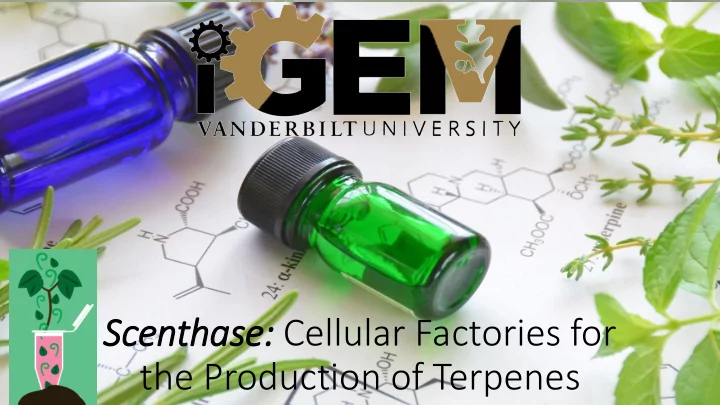

Scenthase: : Cellular Factories for the Production of Terpenes
Our Team After its First Year • Founded by first-year students in December 2013 • First iGEM Team to compete in three Tracks in one year • Small but passionate core team
The Problem: Terpenoid Production Today • What do you get when you add: • Large quantities of deforested plant material • Known carcinogens and environmentally toxic chemicals • High economic demand for rare essential oils (Hu and Corey 2002) • Answer: an impractical and expensive process for synthesizing and extracting rare essential oils and their active ingredients
Where Our Project Comes In : A Better Way to Manufacture Terpenes • Escherichia coli and Saccharomyces cerevisiae • Genetic model systems • Precursors already present • Synthase genes
Meet the Terpenes
Novel Approaches • Don’t synthesize: Grow your own genes • Go where no sequencer has gone before • Full spectrum of fragrance • Assembly lines in the lab • Why settle with one copy when you can have two? (Scherens and Goffeau 2004)
Team Structure: An Experiment in SynBio Education • Nine projects, nine times the opportunities for engagement • 122 members, 60 trained in lab, 4 experiments in 4 weeks • Collaboration with Ravenwood High School iGEM
Getting Genes From Their Source • Greenhouse • Genomic Extractions • Synthase PCR Isolation
Success, But With a Catch (Chang et al 2007)
Another Way for Extracted Genes • RNA Extraction from Plants • RNA cDNA • cDNA Synthase • Site Directed Mutagenesis (Hossain and Levy 2014) (Integrated DNA Technologies)
From Genes to Biobricks to Production • Biobrick standard • Mutagenesis • Prefix and Suffix • pSB1C3 • Cloning into our vector • Expression in E. coli and yeast • GCMS confirmation, plus strep- tag and inducible promoter.
pVU14006 : The Amenities
Building the Vector • PCR Extract Gene Cassettes from existing plasmids • Combine into pUC19 MCS • Mutagenize RFC10 sites • Ligate synthase gene
Results Summary
Acknowledgements Faculty and Staff Assistance: Faculty Advisors: • Dr. Amanda Benson • • Chrissy Marasco Jonathan Ertelt • • Dr. Mark Woelfle • Dr. Kathy Friedman Charles Sissom • Dr. Ian Macara • • Dr. Kevin Seale (emeritus) Dr. Aviva Joesph
Questions and Answers
Recommend
More recommend